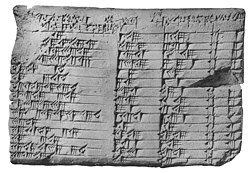History of mathematics (Babylonian mathematics)
Babylonian mathematics
Babylonian mathematics refers to any mathematics of the people of Mesopotamia (modern Iraq) from the days of the early Sumerians through theHellenistic period almost to the dawn of Christianity.[20] It is named Babylonian mathematics due to the central role of Babylon as a place of study. Later under the Arab Empire, Mesopotamia, especially Baghdad, once again became an important center of study for Islamic mathematics.
In contrast to the sparsity of sources in Egyptian mathematics, our knowledge of Babylonian mathematics is derived from more than 400 clay tablets unearthed since the 1850s.[21] Written in Cuneiform script, tablets were inscribed whilst the clay was moist, and baked hard in an oven or by the heat of the sun. Some of these appear to be graded homework.
The earliest evidence of written mathematics dates back to the ancient Sumerians, who built the earliest civilization in Mesopotamia. They developed a complex system of metrology from 3000 BC. From around 2500 BC onwards, the Sumerians wrote multiplication tables on clay tablets and dealt with geometrical exercises and division problems. The earliest traces of the Babylonian numerals also date back to this period.[22]
The majority of recovered clay tablets date from 1800 to 1600 BC, and cover topics which include fractions, algebra, quadratic and cubic equations, and the calculation of regular reciprocal pairs.[23] The tablets also include multiplication tables and methods for solving linear and quadratic equations. The Babylonian tablet YBC 7289 gives an approximation of √2 accurate to five decimal places.
Babylonian mathematics were written using a sexagesimal (base-60) numeral system. From this derives the modern day usage of 60 seconds in a minute, 60 minutes in an hour, and 360 (60 x 6) degrees in a circle, as well as the use of seconds and minutes of arc to denote fractions of a degree. Babylonian advances in mathematics were facilitated by the fact that 60 has many divisors. Also, unlike the Egyptians, Greeks, and Romans, the Babylonians had a true place-value system, where digits written in the left column represented larger values, much as in the decimalsystem. They lacked, however, an equivalent of the decimal point, and so the place value of a symbol often had to be inferred from the context. On the other hand, this "defect" is equivalent to the modern-day usage of floating point arithmetic; moreover, the use of base 60 means that any reciprocal of an integer which is a multiple of divisors of 60 necessarily has a finite expansion to the base 60. (In decimal arithmetic, only reciprocals of multiples of 2 and 5 have finite decimal expansions.) Accordingly, there is a strong argument that arithmetic Old Babylonian style is considerably more sophisticated than that of current usage.
The interpretation of Plimpton 322 was the source of controversy for many years after its significance in the context of Pythagorean triangles was realized. In historical context, inheritance problems involving equal-area subdivision of triangular and trapezoidal fields (with integer length sides) quickly convert into the need to calculate the square root of 2, or to solve the "Pythagorean equation" in integers: rather than considering a square as the sum of two squares, we can equivalently consider a square as a difference of two squares. After division, (c-a)(c+a)= bb becomes the product of two rational numbers giving 1: (c/b-a/b)(c/b+a/b) = 1. This is easily solved by consulting a table of reciprocal pairs. Solutions of the original equation are thus parametrized by the choice of a rational number x, from which Pythagorean-triple right-triangles can easily be constructed by integer-scaling a right-triangle with sides of length 2x, xx-1, xx+1 (should a contemporary mathematician desire to do so). All Pythagorean triples arise in this way, and the examples provided in Plimpton 322 involve some quite large numbers, by modern standards, such as (4601, 4800, 6649) in decimal notation.

Comments
Post a Comment